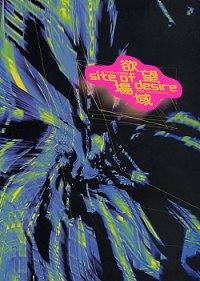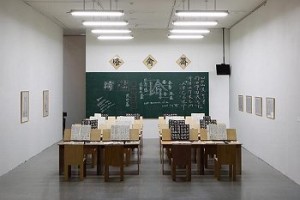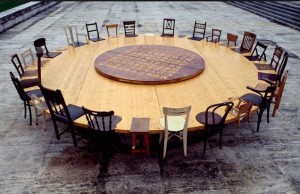In the first North Asian Biennial, work from China, Japan, South Korea and Taiwan raises issues of national identity and tradition.

Cai Guo Qiang, Golden Missile, Taipei Biennial 1998. Photo © the artist.
The Taiwan Domestic Airport was closed down temporarily in June when missiles were fired in the air by a citizen of mainland China. The man in question had arrived in Taipei just days earlier. Estimates range, but the official figure for the number of missiles involved in the incident stands at 200. Residents of northern Taipei were surprised but “not unduly alarmed,” according to one local report, by the flashes of intense light and the terrific noise. No injuries were reported.
The closing of the airport had actually been negotiated in advance by the Taipei Fine Arts Museum, and the missiles had in fact been fired by Cai Guoqiang, a New York-based artist, in a performance at the opening of the Taiwan Biennial. His project, Golden Missile, was one of many radical works in a show that is without question the most important exhibition of contemporary art ever mounted on this island.
Democracy and biennials arrived in Taiwan about the same time, in the early 1980’s. For more than a decade afterward, a sculpture biennial alternated with a painting biennial, so that there was in fact a biennial every year. Then the directors of the Taipei Fine Arts Museum decided that these categories were inadequate to contemporary art, and so they established, in 1996, a new Taiwanese biennial modeled loosely on the Whitney Museum’s, which represents the major trends and tendencies of the moment in American art. Now internationalism has arrived. The current exhibition, the first North Asian Biennial, includes work by artists from Japan, South Korea, Taiwan and mainland China. The show, which runs through Sept. 6, was curated by Nanjo Fumio, a well-known Japanese critic, who commissioned site-specific installations for it. The work ranges from the formal to the didactic to the comical to the acutely political; such profound variety and the ostentatious display of total artistic freedom seem almost incredible in a country that held its first fully open elections little more than two years ago.

Site of Desire: Catalogue of the 1998 Taipei Biennial
The Taiwan Biennial reflects the liberal policies of the Taipei city government, which is led by the leftish Democratic Progressive Party (the national government remains in the hands of the rightish Kuomintang). Though the Taipei government is building several new museums in town, the biennial is the most concrete evidence to date of the authorities’ commitment to culture. It is a tough, provocative, politically eclectic show.
While neighboring sections of the globe have in recent decades assumed clear regional identities — there is, to some degree, a culture of Southeast Asia — the four countries of the north have remained culturally insulated. Each in its way has achieved a level of success and sophistication that has allowed it relative self-sufficiency, and all four are historically isolationist in any case. This biennial takes on the big questions: How do these four countries define an idea of Asia or of the Far East for Western viewers? How does each country combine its own artistic traditions with the modernist idea of internationalism? What constitutes originality in these cultures, and what is the status of originality in each one? How much is it possible or desirable for these societies to escape from their long histories? These questions, which underlie so much modern art from Asia, have never before been negotiated so thoroughly or so publicly.
Mr. Fumio writes in the exhibit’s brochure: “Asia’s cities are seeking a new post-colonial identity as they sculpt modernity. Its economies have grown, heated up and contracted. Its politics are in turmoil, and its democracies are beginning to take on unique shapes. Tradition is being re-examined, reborn and creatively transmitted. Western modernity is learned from, studied, copied, denied.”

Xu Bing, An Introduction to New English Calligraphy, 1995-8.
This exhibit will doubtless affect our understanding of Asian art for the long term. Looking around the show, one can see how a new canon is being etched into the collective conscious. Further evidence of it will be visible in the Asia Society’s “Inside Out” exhibition opening next month in New York.
Mun-Lee Lin, the director of the Taipei museum, and Yulin Lee, the head of its international programs, wanted to insert Taiwan into the Asian-identity dialogue, and to make the island a center for cultural innovation. “In this time of globalization, the idea of ‘Western’ and ‘Asian’ problems is no longer meaningful,” Mr. Lin said. “But as we approach technological par with the West, variations between Western and Eastern Zeitgeist become more potent, more significant and harder to define. We hope this exhibit will forward that debate, to the benefit of both West and East. We have studied the work of other countries as we have grappled with the question of who we are, looking at our local past, at the traditions brought over from the mainland in 1949, at the effect of American support and of the withdrawal of American support. We are a younger and less clearly defined society than are Japan, China and Korea; but it is now time for us to be the hosts, and to establish the place of our own artists.”
The Taipei Fine Arts Museum is one of the worst conceived museum spaces in the world. The cavernous lobby always feels vacant; the glass atrium in the middle of the museum looks like an air shaft in an apartment block; and the galleries are either oppressively low ceilinged or vacantly high ceilinged and all poorly proportioned. Mr. Fumio commissioned artists for specific spaces, and he managed to bring every corner of the museum to life. Six works transform the lobby, including Choi Jeonghwa‘s 40-foot gold column topped by a motorized goddess whose wings beat just below the ceiling.

Chen Zhen, Round Table, 1995.
The dingy atrium has been filled with gigantic asymmetrical black-dotted fuschia balloons by Yayoi Kusama, one of the great names of Japanese modern art. Tied loosely to the atrium walls, these pink dirigibles shift very slightly and very slowly in the wind. They look benign as giant manatees, and the light that reflects off and through them gives the whole museum a welcoming, rosy glow.
The show mixes big names with relative unknowns. In addition to the work of Ms. Kusama, Mr. Choi and Mr. Cai, there are major pieces by such fixtures on the international exhibition scene as Nobuyoshi Araki, Tatsuo Miyajima, Chen Zhen, Ho Chungming and Xu Bing. Mr. Araki spent a month in Taipei photographing the mopeds that are the city’s main form of transportation and then mounted these photographs in the form of a giant mural showing the dynamic motion of the new Taiwan. Mr. Miyajima has installed LED (light emitting diode) displays of unexplained changing numbers in a large room, leaving it dark except for the red and green glow of the shifting digits, evoking calculators, production figures, economics and the passage of time.
Ho Chungming’s woodblocks, mounted like posted bills outside the museum, announce to visitors, “God Hates You: You Are Too Busy” and “God Hates You: You Are Too Lazy” and “God Hates You: You Are Too Fearful.” Xu Bing, in the most sophisticated installation of all, has created a system of English-language characters, made exercise books, set up a classroom with desks, pots of ink, brushes and ink stones and produced a videotape of a teacher lecturing on brush-stroke technique in a voice that is at once deeply respectful and utterly patronizing of Chinese culture.
Much of the work by less-known artists is also effective. Wu Tien Chang has repainted a well-known 1950’s Taiwanese painting of a Shanghai woman walking through a Taiwan market. While the locals are a grimy lot, the woman walks in a soft glow of supernal elegance, a manifestation of the racist views of the mainlanders who arrived in 1949 with Chiang Kai-shek. By projecting a film onto a mirrored reflection of the painting, Mr. Wu creates an illusion that the woman dances toward the viewer while the rest of the painting disappears. Sentimental music plays. As she comes closer, she becomes confusing: is she a woman or the artist in drag? Is she beautiful or grotesque? Welcoming or salacious? Superior or utterly lost?
The Korean artist Kim Beom‘s “Art of Transforming” plays on the ideas of the natural and the unnatural that have plagued Asians as they try to reconcile industry and tradition. In the installation,”How to Become Grass,” there is a text from Mr. Kim that says, in part, : “Let your hair grow long and paste hay on your body. Dye your hair green in summer and ocher in winter. Lie still always, but in spring and fall, after dying your fingertips, point them to the sky and make a wish that your offspring will prosper. Gradually learn how to obtain the hair coloring from nature.”

Lin Yilin, The Result of a Lot of Pieces, Taipei Biennial, 1998. Photo © the Artist.
Some artists, including the Korean Bahc Mo and the Chinese Lin Yilin, built huge projects just outside the museum. Mr. Bahc has created a wonderfully typical, chaotic Asian construction site, while Mr. Lin has made a wall of bricks precariously balanced on one another, with paper money fluttering where there might have been cement.
Another artist, Cai Guoqiang, has caused the entire exterior of the Taipei Museum to disappear under a skin of commerce. Ringing the building is a bamboo advertising scaffold like the ones that enclose so many buildings across Asia, and covering it are actual advertisements, the sale of which helped pay for this hugely expensive project.
As might be expected, underlying any vanguard art show in Taiwan is an implied criticism of the cultural repression that still exists on the mainland. The artists in the biennial who reside in mainland China did not come to Taiwan. Unable to get the necessary exit papers from their own Government, they made their site-specific installations without direct experience of the sites, responding to photographs with drawings and instructions. They will never see the work completed or in place.
None of the strong work of these artists was included in the Guggenheim’s exhibition of 20th-century Chinese art last winter in New York. The curators of that show have said in a letter to Artforum magazine: “We were able to present a history of 20th-century Chinese art that has not been manipulated for political purposes. Chinese institutions are now willing to have the recent past openly re-examined.” The ambivalent position of contemporary Chinese arts in the Taiwan Biennial contravenes such naiveté.











